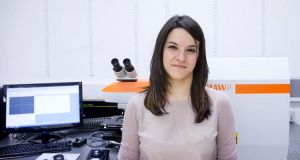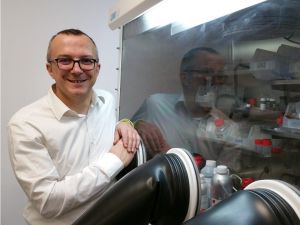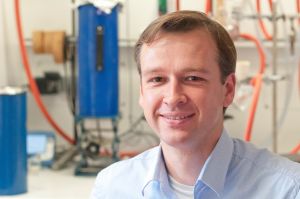
Nanostructured noble carbons and carbon nitride materials: from selective sorption over new energy storage to enzyme-like metal free catalysis
Markus Antonietti*
Max Planck Institute of Colloids and Interfaces, Research Campus Golm, D-14424 Potsdam, Germany, antonietti@mpikg.mpg.de
Carbons made by the technique of “band-control” and doped with the elements N, O, and S have special properties, among them high oxidation resistance and high electronic conductivity. These carbon materials are synthesized by thermal condensation of special monomers, among them for instance nucleobases, or by condensation reactions under high oxidative stress.
I will report on the characterization of such carbons by selective sorption experiments, plus that I will present a new mode of energy storage in those systems. Extending the (old) observation that such carbons are very powerful metal-free electrocatalysts, I will present other “world reactions”, such as the conversion of soda water into formic acid, in this special case illustrating the new chemical tool of modifying bulk heterojunction effects.
When going to even high nitrogen contents, Carbon nitrides or polyheptazineimides are obtained, and the resulting semiconductors can promote artificial photosynthesis, including water splitting and CO2 conversion. I will present a number of completely new organic reactions only possible with such 2d-materials which indicate how such materials could have contributed to the existence of chemical diversity, potentially also on a prebiotic earth-like planet.

Optoelectronic Processes in
Covalent Organic Frameworks
Thomas Bein
Department of Chemistry and Center for NanoScience (CeNS)
University of Munich (LMU), Germany, bein@lmu.de
New opportunities emerge by spatially integrating photoactive molecular building blocks into the crystalline lattice of covalent organic frameworks (COFs), thus creating models for organic bulk heterojunctions and porous electrodes for photoelectrochemical systems. In this presentation, we will address means of controlling the morphology and packing order of COFs in thin films (1) and with spatially locked-in building blocks.(2) Regarding the latter, the design of well-defined periodic docking sites enables us to achieve remarkably high crystallinity with several multidentate building blocks and a series of linear bridging units.
We will discuss different strategies aimed at creating electroactive networks capable of light-induced charge transfer. For example, we have developed a COF containing stacked thienothiophene-based building blocks acting as electron donors with a 3 nm open pore system, which showed light-induced charge transfer to an intercalated fullerene acceptor phase.(3) Contrasting this approach, we have designed a COF integrated heterojunction consisting of alternating columns of stacked donor and acceptor molecules, promoting the photo-induced generation of mobile charge carriers inside the COF network.(4) Moreover, additional synthetic efforts have led to several COFs integrating extended chromophores capable of efficient harvesting of visible light, for example (5). Extending newly developed thin film growth methodology to a solvent-stable oriented 2D COF photoabsorber structure, we have recently established the capability of COF films to serve in photoelectrochemical water splitting systems.(6) The great structural diversity and morphological precision that can be achieved with COFs make these materials excellent model systems for organic optoelectronic systems.
[1] D. D. Medina, J. M. Rotter, Y. H. Hu, M. Dogru, V. Werner, F. Auras, J. T. Markiewicz,
P. Knochel, T. Bein, J. Am. Chem. Soc. 2015, 137, 1016.
[2] L. Ascherl, T. Sick, J. T. Margraf, S. H. Lapidus, M. Calik, C. Hettstedt, K. Karaghiosoff, M. Döblinger, T. Clark, K. W. Chapman, F. Auras, T. Bein, Nature Chem. 2016, 8, 310.
[3] M. Dogru, M. Handloser, F. Auras, T. Kunz, D. Medina, A. Hartschuh, P. Knochel,
T. Bein, Angew. Chem. Int. Ed. 2013, 52, 2920.
[4] M. Calik, F. Auras, L. M. Salonen, K. Bader, I. Grill, M. Handloser, D. D. Medina,
M. Dogru, F. Lobermann, D. Trauner, A. Hartschuh, T. Bein, J. Am. Chem. Soc. 2014, 136, 17802.
[5] N. Keller, D. Bessinger, S. Reuter, M. Calik, L. Ascherl, F. C. Hanusch, F. Auras, T. Bein, J. Am. Chem. Soc. 2017, 139, 8194.
[6] T. Sick, A. G. Hufnagel, J. Kampmann, I. Kondofersky, M. Calik, J. M. Rotter, A. Evans, M. Döblinger, S. Herbert, K. Peters, D. Böhm, P. Knochel, D. D. Medina, D. Fattakhova-Rohlfing, T. Bein, J. Am. Chem. Soc. 2018, 140, 2085.

Ultrafast Charge Carrier Dynamics in Graphene Nanoribbons
Mischa Bonn
Max Planck Institute for Polymer Research, Ackermannweg 10, 55128 Mainz, Germany
Graphene has outstanding electronic properties, in particular supporting an extremely high electron mobility. Yet, the vanishing bandgap of graphene can present a disadvantage for applications such as photovoltaics. A chemical synthesis approach was recently demonstrated that enables making well-defined, narrow graphene nanoribbons (GNRs) with widths as small as ~1 nm. In these structures, carrier confinement in the lateral dimension induces a bandgap corresponding to visible wavelengths. We investigate the effect of confinement on the mobility and lifetime of charge carriers, and study the role of chemical functionalization of the nanoribbon edge on that mobility.

Water-based and biocompatible 2D-material inks for all-printed heterostructures
Cinzia Casiraghi
Affiliation: School of Chemistry,
University of Manchester
e-mail: cinzia.casiraghi@manchester.ac.uk
The isolation of various two-dimensional (2D) materials allows to combine them into heterostructures. Such a concept can be used to make functional devices. Solution processing of 2D materials [1] allows simple and low-cost techniques such as inkjet printing [2, 3] to be used for fabrication of heterostructure of arbitrary complexity. However, the success of this technology is determined by the nature and quality of the inks used. Furthermore, these formulations must be suitable for all-inkjet printed heterostructure fabrication - the remixing of different 2D crystal gives rise to uncontrolled interfaces, resulting in poor performance and lack of reproducibility of the devices.
In this work we show a general formulation engineering approach to achieve highly concentrated, and inkjet printable water-based 2D crystal formulations, which also provide optimal film formation for multi-stack fabrication [4]. Examples of all-inkjet printed heterostructures, such as arrays of photosensors [4], logic memory devices [4], strain sensors [5] and capacitors [6] will be discussed. In particular the capacitors are used to demonstrate all-2D fully printed band pass filters and graphene-based field-effect transistors.
[1] Coleman et al., Science 331, 568 (2011)
[2] Torrisi et al, ACS Nano 6, 2992 (2012)
[3] Finn et al. J. Mat. Chem. C 2, 925 (2014)
[4] McManus et al, Nature Nanotechnology, doi:10.1038/nnano.2016.281 (2017)
[5] Casiraghi et al, Carbon, 129, 462 (2018)
[6] Worsley et al, submitted

Interfacing functional molecules with 2D materials
Eugenio Coronado
Instituto Ciencia Molecular (ICMol),
Univ. Valencia
e-mail: eugenio.coronado@uv.es
The emergence of van der Waals heterostructures formed by assembling two different monolayers of these materials have opened new opportunities in this field. This concept can be further expanded by interfacing a layered 2D material with materials of other dimensionalities including 0D materials (molecules, nanoparticles,…), 1D materials (nanotubes, nanowires,…) and 3D materials, which can interact non only through VdW forces but also through covalent or ionic interactions [1]. Here I propose to create heterostructures based on functional molecules and 2D materials with the aim of tuning the properties of the “all surface” 2D material via an active control of the hybrid interface. This concept will provide an entire new class of stimuli-responsive molecular/2D heterostructures, which may be at the origin of a novel generation of hybrid materials and devices of direct application in highly topical fields like electronics, spintronics, molecular sensing and energy storage. I will focus in particular in heterostructures in which both or at least one of the two components are magnetic. This concept will be illustrated with two examples i) Chemically functionalized 2D magnetic coordination polymers [2], and ii) Hybrid heterostructures based on spin crossover nanoparticles and 2D materials [3].
[1] D. Jariwala, et al. “Mixed Dimensional van der Waals Heterostructures”Nature Mater 2017, 16, 170.
[2] D. Jariwala, et al. “Isoreticular two-dimensional magnetic coordination polymers prepared through pre-synthetic ligand functionalization”Nature Chem 2018, in press.
[3] J. Dugay et al. “Phase transitions in spin crossover thin films probed by graphene transport measurements”, Nano Lett. 2017, 17, 186.

Electrocatalysis on nanoparticle derived aerogels
Alexander Eychmüller and Bin Cai
Physical Chemistry, Department of Chemistry, Bergstr. 66b, TU Dresden,
alexander.eychmueller@chemie.tu-dresden.de
After we summarized our work on the electrocatalysis on (multi-)metallic (aero-)gels [1] we concentrated our work on the amelioration of the building blocks as a plausible approach to graft aerogels with distinguished properties while preserving the aerogel superiority. We report on the first case of an aerogel electrocatalyst composed entirely of alloyed PdNi hollow nanospheres with controllable chemical composition and shell thickness. This work expands the exploitation approach of electrocatalytic properties of aerogels into morphology and composition control of its building blocks.[2] In a further study, we prepared and analyzed a new class of hierarchical aerogels composed of multimetallic Ni-PdxPty nanoparticle building blocks with continuously engineered shape and compositions. This approach results in aerogels with hierarchical structures organizing the nanoscale regulated architecture and macroscale three-dimensional network structure.[3] In a final example we`ll line out how core-shell structuring of pure metallic aerogels can be tuned towards highly efficient Pt utilization for the oxygen reduction reaction.[4]
References
[1] W. Liu, A.-K. Herrmann, N.C. Bigall, P. Rodriguez, D. Wen, M. Oezaslan, T.J. Schmidt, N. Gaponik and A. Eychmüller, Acc. Chem. Res. 48, 154 (2015).
[2] B. Cai, D. Wen, W. Liu, A.-K. Herrmann, A. Benad, A. Eychmüller, Angew. Chem. Int. Ed. 54, 13101 (2015).
[3] B. Cai, A. Dianat, R. Hübner, W. Liu, D. Wen, A. Benad, L. Sonntag, T. Gemming, G. Cuniberti, A. Eychmüller, Adv. Mater. 29, 1605254 (2017).
[4] a) B. Cai, R. Hübner, K. Sasaki, Y. Zhang, D. Su, C. Ziegler, M.B. Vukmirovic, B. Rellinghaus, R.R. Adzic, A. Eychmüller, Angew. Chem. Int. Ed. 57, 2963 (2018). b) B. Cai, V. Sayevich, N. Gaponik, A. Eychmüller, Adv. Mater., in press (DOI: 10.1002/adma.201707518).

Topological quantum chemistry
Claudia Felser, Johannes Gooth, Shekhar Chandra, Nitesh Kumar
Solid State Chemistry, Max Planck Institute Chemical Physics
Nöthnitzer Str.40, 01187 Dresden
e-mail:felser@cpfs.mpg.de
Topology a mathematical concept became recently a hot topic in condensed matter physics, solid state chemistry and materials science. One important criteria for the identification of topological material is the band inversion, known as the “inert pair effect” in chemistry and a certain crystal symmetry [1]. In my talk I focus on the design criteria for topological materials ranging from topological insulators via semimetals to metals. The result of a topological non-trivial electronic structures are surface state and new properties, many still to be discovered.
The most exciting property for me is the concept of the chiral anomaly which were discussed as one reason for the asymmetry between matter and antimatter and were recently found in Weyl semimetal [2]. Binary phoshides are the ideal material class for a systematic study of Weyl physics and chemitry. Weyl points, a new class of topological phases was also predicted in NbP, NbAs. TaP, MoP and WP2. In NbP micro-wires we have observed the chiral anomaly but NbP has served also as a model system for astrophysics: realizing the gravitational anomaly in NbP [3,4] and the hydrodynamic flow of electrons in WP2. MoP and WP2 show exceptional properties such as high conductivity higher than clean copper, high mobilties and a high magneto-resistance effect [5,6]. The mean free path of the electrons can be as large as one mm. However, I will discuss the potential of this new field for chemistry.
The work was done in collaboration with the team of Kornelius Nielsch (IFW Dresden), Tobias Meng (TU Dresden), Andrei Bernevig (Princeton)
[1] Barry Bradlyn, et al., “Topological quantum chemistry” Nature , (2017) 547, 298
[2] Binghai Yan and Claudia Felser, “Topological Materials: Weyl Semimetals”, Annual Review in Condensed Matter (2017) 8, 337.
[3] Chandra Shekharet al., “Extremely large magnetoresistance and ultrahigh mobility in the topological Weyl semimetal NbP”, Nature Physics (2015) 11, 645.
[4] Johannes Gooth, et al., “Experimental signatures of the gravitational anomaly in the Weyl semimetal NbP” Nature (2017) 547 324
[5] Nitesh Kumar, et al., “Extremely high magnetoresistance and conductivity in the type-II Weyl semimetal MoP2 and WP2”, Nature Communications (2017) 8 1642
[6] J. Gooth, F. Menges, C. Shekhar, V. Süβ, N. Kumar, Y. Sun, U. Drechsler, R. Zierold, C. Felser, B. Gotsmann, “Electrical and Thermal Transport at the Planckian Bound of Dissipation in the Hydrodynamic Electron Fluid of WP2”, preprint arXiv:1706.05925

Light Scattering and Emission from Hetero-structures
Andrea C. Ferrari
Cambridge Graphene Centre, University of Cambridge, Cambridge, CB3 OFA, UK
Heterostructures based on layers of atomic crystals have a number of properties often unique and very different from those of their individual constituents and of their three dimensional counterparts. The combinations of such crystals in stacks can be used to design the functionalities of such heterostructures. I will show how Raman spectroscopy can be used to fingerprint such heterosctructures, and how these can be exploited in novel light emitting devices, such as single photon emitters, and tuneable light emitting diodes.

Carbon Nanomembranes with sub-nanometer channels:
2D materials for water purification
Armin Gölzhäuser
Physics of Supramolecular Systems and Surfaces,
Bielefeld University, 33615 Bielefeld, Germany
e-mail: ag@uni-bielefeld.de
Clean water is a global challenge, and membrane filtration is a key technology to achieve it. There are growing research efforts to explore the use of 2D carbon materials as nanoconduits for molecular transport and separation [1]. Here, I report on carbon nanomembranes (CNMs) with sub-nanometer channels that prove to be excellent water filters, combining a high selectivity with an exceptionally high water permeance. The CNMs are fabricated via the cross-linking of terphenyl self-assembled monolayers [2], resulting in a ~1.2 nm thick membrane perforated by channels with diameters below ~0.7 nm and areal densities of ~1018 m−2. When tested as filter membranes, it was found that the CNMs efficiently block the passage of most gases and liquids. However, water passes through with an exceptionally high permeance of ~1.0×10−4 mol·m−2·s−1·Pa−1 [3]. This suggests that water fast and cooperatively translocates through a channel with a rate of ~66 molecules·s−1·Pa−1. As the fabrication of CNMs is scalable, this finding can open new paths towards the use of 2D materials in water purification.
[1] Park, H. G.; Jung, Y.: Carbon nanofluidics of rapid water transport for energy applications. Chem. Soc. Rev. 2014, 43 (2), 565-576.
[2] A. Turchanin and A. Gölzhäuser: Carbon Nanomembranes, Adv. Mater. 2016, 28, 6075.
[3] Y. Yang, P. Dementyev, N. Biere, D. Emmrich, P. Stohmann, R. Korzetz, X. Zhang,
- Beyer, S. Koch, D. Anselmetti, A. Gölzhäuser, under review 2018.

Advanced Nanocarbon Materials for Solar Energy Conversion Schemes
Dirk M. Guldi
Department of Chemistry and Pharmacy 7 Interdisciplinary Center for Molecular Materials (ICMM), Friedrich-Alexander-Universitaet Erlangen-Nuernberg, Egerlandstr. 3, 91058 Erlangen, Germany
dirk.guldi@fau.de
Carbon is the key to many technological applications that have become indispensable in our daily life. Altering the periodic binding motifs in networks of sp3-, sp2-, and sp-hybridized C-atoms is the conceptual starting point for a wide palette of carbon allotropes. To this end, the past two decades have served as a test-bed for measuring the physico-chemical properties of low-dimensional carbon with the advent of fullerenes (0D), followed in chronological order by carbon nanotubes (1D), carbon nanohorns, and, most recently, by graphene (2D). These species are now poised for use in catalysis.
Expanding global needs for energy have led to a significant effort to develop alternatives to fossil fuels. While alternative sources for energy are already in use, they comprise a small percentage of the energy demands needed to carry us through the 21st century. No single source will solve the global needs, but the development of photocatalysis has vast potential as a point-of-use power source.
I report on our efforts regarding a unifying strategy to use the unprecedented charge transfer chemistry of 0D fullerenes, the ballistic conductance of 1D carbon nanotubes, and the high mobility of charge carriers in 2D graphene, together in a groundbreaking approach to solving a far-reaching challenge, that is, the efficient use of the abundant light energy around us. For example, hybrid materials based on nanocarbons and metaloxides are the ideal design for realizing breakthroughs in high photon conversion efficiencies suitable for the catalysis of water.

Two-dimensional crystals in three dimensions
Roman Kempt, Agnieszka Kuc, Thomas Heine
Faculty of Chemistry and Food Chemistry, TU Dresden, 01062 Dresden, Germany
e-mail: thomas.heine@tu-dresden.de
Optoelectronic properties of two-dimensional crystals, single sheets of layered materials, are often distinct from their bulk counterparts, and in principle superior for applications. For example, band gaps are generally larger, in some cases direct, ideally suited for optoelectronic and photocatalytic applications. However, being atomically thin, the low materials density is a bottleneck for high volumetric yield. Based on our recent work [1], we propose to intercalate layered materials with short surfactants that electronically decouple the layers, effectively resulting in the same electronic properties as in the monolayers, but with much higher volumetric performance.
[1] S. Jeong, D. Yoo, M. Ahn, P. Miro, T. Heine, J. Cheon, “Tandem intercalation strategy for single-layer nanosheets as an effective alternative to conventional exfoliation processes”, Nature Commun. 2015, 6, 5763.

Chemical Functionalization of Synthetic Carbon Allotropes and the Advent of Black Phosphorus
Andreas Hirsch, Department of Chemistry and Pharmacy, University of Erlangen-Nuremberg
Nikolaus-Fiebiger-Strasse 10, 91058 Erlangen, Germany, E-mail: andreas.hirsch@fau.de
Chemical functionalization of new C-allotropes is of fundamental interest and opens the door to unprecedented materials applications. In principle, the physical and chemical properties of fullerenes, carbon nanotubes (CNTs) and graphene are related to each other, although their levels of development vary considerably. In order to efficiently explore the reactivity of the less developed CNTs and especially that of graphene it is our goal to provide a unifying approach for the chemistry of all three new carbon allotropes. The fullerenes present the first family of synthetic carbon allotropes. Since their availability in macroscopic quantities numerous investigations with respect to their physical characterization and chemical functionalization have been carried out. CNTs - the second new family of C-allotropes - exhibit at least the same potential for unprecedented applications. Their chemistry, however, is much less developed. Although many protocols for covalent and non-covalent CNT functionalization have been published there are still many fundamental problems to be solved. This includes inter alia the highly selective functionalization of metallic- or semiconducting SWNTs, the high throughput isolation of SWNTs with single helicity, the development of general concepts allowing for tunable doping of individualized tubes with single helicity or least defined transport characteristics (metallic – semiconductive). Finally, the youngest representative in the list of new C-allotropes is graphene and the exploration of its chemistry has just begun to start. So far only investigation on the functionalization of defect rich graphene oxide (GO) but not intact graphene itself have been published. Compared to the various flavours of CNTs (broad variation of helicities, single walled, multi walled) graphene is a much more uniform material. This will facilitate the development of its chemistry considerably. We will present a series of new results of covalent and non-covalent functionalizations of fullerenes, carbon nanotubes and graphene. Moreover, we will present first results on the chemical functionalization of other 2D-materials such as black phosphorus

Macroscopic heteroatom-doped nanoporous carbon membranes: from synthesis to high-performance electrode
Jiayin Yuan
Department of Materials and Environmental Chemistry, Stockholm University, 10691 Stockholm, Sweden (jiayin.yuan@mmk.su.se)
Freestanding nanoporous carbon membranes hold great promise in catalysis, separation, and electrochemical energy conversion, just to name a few, due to their structural integrity, continuity and purity. Typical synthetic methods involve mechanical rolling of thermally expanded graphite flakes, chemical vapour deposition, vacuum filtration of dispersed graphene or carbon nanotubes, and pyrolysis of thermosetting polymer precursors. Precise control over the atomic order, local chemical composition, nanoscale morphology and complex pore architecture, plus easy access to large sized nanoporous carbon membranes of high surface area is highly relevant, yet synthetically challenging. Particularly, a high degree of graphitization and hierarchical, interconnected pores are eagerly pursued because they offer fast electron conduction, rapid transport kinetics, and simultaneously high-reaction capacity.
Through a bottom–up templating approach, we were able to fabricate hierarchically structured, nitrogen-doped, graphitic nanoporous carbon membranes in a macroscopic size scale. In particular, the pores along the membrane cross-section assume a gradient distribution in their sizes, which is seldom observed in such membranes. The pristine nanoporous carbon membranes exhibit an unusually high graphitization degree, excellent conductivity, and oxidation resistance.[1] The multiple structural merits enable such carbon membrane as high-performance electrode in electrochemical energy fuel production, including hydrogen, format and ammonia. [2-4]
References
1)H. Wang, et al., Synthesis of Single-crystal-like Nanoporous Carbon Membranes and Their Applications in Overall Water Splitting. Nat. Commun. 2017, 8, 13592.
2)H. Wang, et al., Nitrogen-Doped Nanoporous Carbon Membranes with Co/CoP Janus-Type Nanocrystals as Hydrogen Evolution Electrode in Both Acid and Alkaline Environment. ACS Nano, 2017, 11 (4), 4358–4364.
3)H. Wang, et al., Efficient Electrocatalytic Reduction of CO2 by Nitrogen-Doped Nanoporous Carbon/Carbon Nanotube Membranes – A Step Towards the Electrochemical CO2 Refinery. Angew. Chem. Int. Ed. 2017, 56,7847 –7852.
4)H. Wang, et al., Ambient Electro-Synthesis of Ammonia - Electrode Porosity and Composition Engineering. Angew. Chem. Int. Ed. 2018, 10.1002/anie.201805514.

Advanced Materials for Lithium Sulfur Batteries
Stefan Kaskel
Department of Chemistry, Bergstr. 66, TU Dresden,
and Fraunhofer IWS, Winterbergstr. 28, Dresden
Stefan.kaskel@tu-dresden.de
Lithium sulfur batteries are considered as the next generation batteries due to their high gravimetric energy density up to 350-400 Wh/kg. Highly porous carbon materials with surface areas up to 3000 m2/g play a key role for the performance of such systems. A key requirement is to achieve a high sulfur loading up to 75 wt. % in the cathode and high degree of sulfur utilization. In particular challenging is to identify new electrolytes to achieve high cycling stability. Electrolyte minimization is an often overlooked requirement to achieve high energy densities in prototype cells. The development of porous carbon materials for lithium sulfur batteries requires pore size and polarity tailoring.[1-8] Mesoporous carbon materials are ideally suited as sulfur host for the lithium sulfur batteries. Microporous carbons (d < 2 nm) show high sulfur utilization but the overall sulfur loading is limited to a maximum of about 50 wt % sulfur posing limitations to achieve a high gravimetric energy density. Hard carbons are highly promising anode materials to achieve up to 4000 cycles in a lithium sulfur battery with only minor degradation.[3] Moreover, sodium sulfur batteries can operate with this concept at room temperature.[5,7] The presentation will give an overview on the progress, challenges, and open fundamental questions in the field of sulfur based batteries.
[1] J. T. Lee, Y. Zhao, S. Thieme, H. Kim, M. Oschatz, L. Borchardt, A. Magasinski, W. Cho, S. Kaskel, G. Yushin, Adv. Mater. 2013, 25, 4573–4579.
[2] I. Bauer, S. Thieme, J. Brückner, H. Althues, S. Kaskel, J. Power Sources, 2014, 251, 417–422.
[3] J. Brückner, S. Thieme, F. Böttger-Hiller, I. Bauer, H. T. Grossmann, P. Strubel, H. Althues, S. Spange, S. Kaskel, Adv. Funct. Mater. 2014, 24, 1284–1289.
[4] S. Thieme, J. Brückner, I. Bauer, M. Oschatz, L. Borchardt, H. Althues, S. Kaskel, J. Mater. Chem. A 2013, 1, 9225.
[5] M. Kohl, F. Borrmann, H. Althues, S. Kaskel, Adv. Energy Mater. 2016, 6, 1502185.
[6] P. Strubel, S. Thieme, T. Biemelt, A. Helmer, M. Oschatz, J. Brueckner, H. Althues, S. Kaskel, Adv. Funct. Mater. 2015, 25(2), 287.
[7] S. Thieme, J. Brueckner, A. Meier, I. Bauer, K. Gruber, J. Kaspar, A. Helmer, H. Althues, M. Schmuck, S. Kaskel, J. Mater. Chem. A 2015, 3(7), 3808.
[8] G.P. Hao, C. Tang, E. Zhang, P. Zhai, J. Yin, W. Zhu, Q. Zhang, S. Kaskel, Adv. Mater. 2017, 29, 37.

Advancing 2D Materials for solar energy conversion:
2D frameworks as platforms for light-driven hydrogen evolution
Bettina V. Lotsch
Max Planck Institute for Solid State Research, Heisenbergstraße 1, 70569 Stuttgart
The generation of solar fuels by means of photocatalysis is an attractive strategy to sidestep our dependency on fossil fuels. Although heterogeneous photocatalysts abound, their tunability is often limited and mechanistic insights remain elusive. On the other hand, homogeneous catalysts offer a platform for rational catalyst design, but suffer from inherently low stabilities. Combining the best of both worlds thus opens up new possibilities for the design of tailor-made photocatalysts.
Covalent organic frameworks (COFs) and carbon nitrides show promise as a new generation of molecularly tunable, earth-abundant photocatalysts that combine the stability of heterogeneous systems with the single-site definition of homogeneous catalysts. In this talk, I will outline our recent progress in carving out structure – property – function relationships in 2D framework materials and discuss possible catalyst optimization strategies – through structure, morphology, and active site engineering – and challenges lying ahead in the emerging field of “soft photocatalysis”.
- S. Vyas, F. Haase, L. Stegbauer, G. Savasci, F. Podjaski, C. Ochsenfeld, B. V. Lotsch, Nat. Commun. 2015, 6, 8508
- W.-h. Lau, I. Moudrakovski, T. Botari, S. Weinberger, M.B. Mesch, V. Duppel, J. Senker, V. Blum, B.V. Lotsch, Nat. Commun. 2016, 7, 12165
- Kasap, C. Caputo, B. Martindale, R. Godin, V.W.-h. Lau, B.V. Lotsch, J. Durrant, E. Reisner, J. Am. Chem. Soc.2016, 138, 9183
- W.-h. Lau, D. Klose, H. Kasap, F. Podjaski, M.-C. Pigne, E. Reisner, G. Jeschke, B. V. Lotsch, Angew. Chem. Int. Ed. Int. Ed. 2017, 56, 510
- Stegbauer, S. Zech, G. Savasci, T. Banerjee, F. Podjaski, K. Schwinghammer, C. Ochsenfeld, B.V. Lotsch, Adv. Energy Mater.2018, accepted
- Haase, E. Troschke, G. Savasci, T. Banerjee, V. Duppel, S. Dörfler, M. Grundei, A.M. Burow,
C. Ochsenfeld, S. Kaskel, B.V. Lotsch, Nature Comm.2018, accepted

Synthetic Chiral Carbon Nanoforms
Nazario Martín
aDpto de Química Orgánica, Facultad de Química, Universidad Complutense, E-28040 Madrid, Spain
bIMDEA-Nanociencia, Ciudad Universitaria de Cantoblanco, E-28049, Madrid, Spain
http://www.nazariomartingroup.com/
Chirality is an important and fascinating concept which, however, has not been properly addressed in nanocarbons science.1 Previous results from our group support the basic idea that the chemistry of fullerenes, as probably the most studied carbon nanostructure from a synthetic point of view, is not fully developed. A variety of fundamental reactions – mainly involving transition metals and organocatalysts – have allowed us addressing issues such as regio- and stereo-selectivity in the fullerenes functionalization.2
Chirality in graphene and, more specifically, in graphene quantum dots (GQDs), has also been almost neglected despite the interest for further applications. In particular, when considering the potential applications of GQDs, chirality is an important aspect that can severely influence their performance and that has not been addressed so far. We have recently proven the principle that chiral graphene quantum dots (CGQDs) can be obtained by reaction of oxidized GQDs with enantiomerically pure (R) or (S)-2-phenyl-1-propanol and that their chirality transferred to the supramolecular assemblies formed with small molecules such as pyrene.3
Finally, as a proof of concept, we have recently published the synthesis and characterization of the first inherently chiral bilayer nanographene with a helicene linker, both as the racemate and the M isomer with 93% ee.4 By extending precedented [6]helicene starting material, we obtained an unprecedented folded, chiral nanographene comprised of two hexa-peri-hexabenzocoronene layers fused to a [10]helicene (Figure). The rigidity of the helicene linker forces the layers to adopt a nearly-aligned AA-stacked conformation rarely observed in few-layer graphene.
In this communication, the aforementioned results as well as the most recent findings will be discussed.
Figure. First inherently chiral bilayer nanographene.
- E. E. Maroto, M. Izquierdo, S. Reboredo, J. Marco-Martínez, S. Filippone, N. Martín "Chiral Fullerenes from Asymmetric Catalysis" Acc. Chem. Res. 2014, 47, 2660−2670.
- (a)Filippone, S., Maroto, E.E., Martín-Domenech, A., Suarez, M. and Martín, N., Nature Chem., 2009, 1, 578; (b) Maroto, E. E.; de Cozar, A.; Filippone, S.; Martin-Domenech, A.; Suarez, M.; Cossio, F. P.; Martín, N. Angew. Chem. Int. Ed., 2011, 50, 6060; (c) Sawai, K.; Takano, Y.; Izquierdo, M.; Filippone, S.; Martín, N.; Slanina, Z.; Mizorogi, N.; Waelchli, M.; Tsuchiya, T.; Akasaka, T.; Nagase, S. J. Am. Chem. Soc., 2011, 133, 17746; (d) Maroto, E.E., Filippone, S., Martín-Domenech, A., Suarez, M. and Martín, N., J. Am. Chem. Soc. 2012, 134, 12936; (e) E. E. Maroto, S. Filippone, M. Suárez, R. Martínez-Álvarez, A. de Cózar, F. P. Cossío, N. Martín, J. Am. Chem. Soc., 2014, 136, 705.
- M. Vázquez-Nakagawa, L. Rodríguez-Pérez, M. A. Herranz, N. Martín,Chem. Commun.2016, 52, 665-668. See also: N. Suzuki, Y. Wang, P. Elvati, Z.-B. Qu, K. Kim, S. Jiang, E. Baumeister, J. Lee, B. Yeom, J. H. Bahng, J. Lee, A. Violi, N. A. Kotov, ACS Nano 2016, 10, 1744-1755.
- P. J. Evans, J. Ouyang, L. Favereau, J. Crassous, I. Fernández, J. Perles Hernáez, N. Martín, Angew. Chem. Int. Ed. 2018, 57, 6774-6779.DOI: 10.1002/anie.201800798.

From Twisted Aromatics to 2D Organic Frameworks
*A. Mateo-Alonso1)2)
1) POLYMAT, University of the Basque Country UPV/EHU. Avenida de Tolosa 72, E-20018 Donostia-San Sebastián, Spain.
2) Ikerbasque, Basque Foundation for Science. Bilbao, Spain.
* amateo@polymat.eu
Keywords: Aromatics, distorted, polycyclic aromatic hydrocarbons, conjugated microporous polymers, covalent organic frameworks
Polycyclic aromatic hydrocarbons (PAHs) are receiving a great deal of attention because of their increasingly better performance in organic electronic applications. In general, PAHs are planar structures but they can adopt twisted conformations as the result of the steric strain induced by overcrowding or congestion in key positions of the aromatic core. twisted-PAHs have shown enhanced solubility and unique optoelectronic and chiroptical properties as an effect of their distorted molecular structure. We have implemented several strategy that provides access to a twisted-PAHs in the preparation of organic frameworks that span hundreds of nanometers in two dimensions. The most recent advances of these twisted 2D materials including synthetic routes, optoelectronic properties, self-organising properties, and potential applications will be discussed.
References
1) A. Mateo-Alonso Chem. Soc. Rev., 43, 6311-6324 (2014).
2) S. More, S. Choudhary, A. Higelin, I. Krossing, M. Melle-Franco, A. Mateo-Alonso Chem. Comm., 50, 1976-1979 (2014).
3) S. Choudhary, C. Gozalvez, A. Higelin, I. Krossing, M. Melle-Franco, A. Mateo-Alonso Chem. Eur. J., 20, 1525-1528 (2014).
4) A. B. Marco, D. Cortizo-Lacalle, I. Perez-Miqueo, G. Valenti, A. Boni, J. Plas, S. De Feyter, F. Paolucci, M. Montes, A. Khlovystov, M. Melle-Franco and A. Mateo-Alonso Angew. Chem. Int. Ed., 56, 6946 –6951 (2017).

Tunable graphene-based membranes
Prof. Rahul R. Nair
National Graphene Institute and School of Chemical Engineering and Analytical Science, University of Manchester, Manchester, UK
Keywords: Graphene, graphene-based membranes, van der Waals pressure
Permeation through nanometre-pore materials has been attracting unwavering interest due to fundamental differences in governing mechanisms at macroscopic and molecular scales, the importance of water permeation in living systems, and relevance for filtration and separation techniques. Latest advances in the fabrication of artificial channels and membranes using two-dimensional (2D) materials have enabled the prospect of understanding the nanoscale and sub-nm scale permeation behaviour of water and ions extensively. In particular, graphene oxide (GO) membrane containing 2D graphene capillaries shows unique permeation properties such as ultrafast permeation of water and molecular sieving. In my talk, I will discuss our recent results on molecular and ionic permeation properties of GO membranes and its prospect for several applications.
Reference
- Nair et al. Science 335, 442 (2012).
- Joshi et al. Science, 343, 752 (2014).
- Su et al. Nature Communications 5, 4843 (2014).
- J. Abraham et al. Nature Nanotechnology 12, 546-550 (2017).
- Q. Yang et al. Nature Materials 16, 1198 (2017)
- A Esfandiar et al. Science 358, 511-513 (2017)

Carbon based Radicals for Advanced Materials
Concepció Rovira
Institut de Ciència de Materials de Barcelona (ICMAB-CSIC)/CIBER-BBN, Campus de la UAB, 08193, Bellaterra, Spain.
e-mail: cun@icmab.es
Stable organic radicals have been used in the last decades to develop very interesting materials ranging from polymers and dendrimers to crystals and nanoparticles. Those materials show a multitude of properties that goes from ferromagnets, magnetic sponges, energy storage, 2D photon absorption, to MRI contrast agents etc. We have used Perchlorotriphenylmethyl (PTM) based radicals to construct a number of stable multi-functional materials and devices. PTM is a paramagnetic and electronically switchable compound that has attracted a great deal of attention in the field of molecular electronics and spintronics with many derivatives studied in solution, crystals, under the form of Self-Assembled Monolayers (SAMs) or in molecular junctions. These radical systems exhibit a high chemical and thermal stability and present very different electronic, optical, and magnetic properties compared to the corresponding closed-shell forms.
This talk will be centred in surfaces modified with PTM derivatives, focusing the attention on the switchable properties and on the effect of the unpaired electron on the electronic/spintronic properties.

Topochemistry and Delamination of Layered Topological Insulators
Prof. Dr. Michael Ruck, Faculty of Chemistry and Food Chemistry, TU Dresden, Germany
A topological insulator (TI) is a quantum material that provides fast and dissipation-free transport of information at room temperature.[1, 2] This recommends them as ultimate materials for spintronics and quantum computing close to the atomic limit of nanoelectronics. The TI has a narrow band in the bulk, but a topologically protected metallic surface state. This special surface state is based on symmetry and the spin-orbit coupling generated hybridization of states on both sides of the band gap. Electrons in topologically protected surface states are sheltered against scattering by impurities and their spin is locked to their propagation direction. Still, the number of well characterized TIs is rather limited, and many of them are not suitable for industrial use. Moreover, thin layers are required for technological application.
Layers of Bi2Te3, the most prominent TI, were obtained by mechanical exfoliation as well as by gas-phase deposition.[3] However, none of these methods was able to provide larger amounts of good quality 2D materials at reasonable costs. In contrast, lithium intercalation and solution processing of Bi2Te3 led to stable suspensions of exfoliated layers, which could be processed further.[4] In the past years, our group succeeded in contributing to five families of compounds that show TI properties: (A) Bi14Rh3I9 and variants thereof,[5, 6] (B) BinTeX (n = 1, 2, 3; X = Br, I),[10] (C) Bi2nMnTe3n+1 (n = 1, 2, 3), (D) QXTe (Q = Ga, In; X = Ge, Sn),[11] and (E) Bi4X4 (X = Br, I).[12, 13] The families A to D have layered crystal structures with certain contrast in the strength and type of chemical bonding, which is a necessity for the exfoliation of individual functional layers. We managed to swell and chemically exfoliate Bi14Rh3I9 and Bi2TeI down to packages of few layers. Electron diffraction patterns indicate that the topological non-trivial RhBi4] and the TeBiI] layers, i.e. the 2D TIs, chemically survive the procedure. GaGeTe was successfully exfoliated by another group.[14] We studied underlying topochemistry also on chemically and structurally related metallic and superconducting compounds.[15, 16]
[1] B. A. Bernevig, T. L. Hughes, S.-C. Zhang, Science 2006, 314, 1757–1761.
[2] M. König, S. Wiedmann, C. Brüne, A. Roth, H. Buhmann, L. W. Molenkamp, X.-L. Qi, S.-C. Zhang, Science 2007, 318, 766–770.
[3] W. Tian, W. Yu, J. Shi, Y. Wang, Materials 2017, 10, 814.
[4] Z. Ding, L. Viculis, J. Nakawatase, R. B. Kaner, Adv. Mater. 2001, 13, 797–800.
[5] B. Rasche, A. Isaeva, M. Ruck, S. Borisenko, V. Zabolotnyy, B. Büchner, K. Koepernik, C. Ortix, M. Richter, J. van den Brink, Nat. Mater. 2013, 12, 422–425.
[6] C. Pauly, B. Rasche, K. Koepernik, M. Liebmann, M. Pratzer, M. Richter, J. Kellner, M. Eschbach, B. Kaufmann, L. Plucinski, C. M. Schneider, M. Ruck, J. van den Brink, M. Morgenstern, Nat. Phys. 2015, 11, 338–343.
[10] A. Isaeva, B. Rasche, M. Ruck, Phys. Status Solidi RRL 2013, 7, 39–49.
[11] A. Zeugner, M. Kaiser, P. Schmidt, T. V. Menshchikova, I. P. Rusinov, A. V. Markelov, W. Van den Broek, E. V. Chulkov, T. Doert, M. Ruck, A. Isaeva, Chem. Mater. 2017, 29, 1321–1337.
[12] F. Pielnhofer, T. V. Menshchikova, I. P. Rusinov, A. Zeugner, I. Yu. Sklyadnevab, R. Heid, K.-P. Bohnen, P. Golub, A. I. Baranov, E. V. Chulkov, A. Pfitzner, M. Ruck, A. Isaeva, J. Mater. Chem. C 2017, 5, 4752–4762.
[13] G. Autès, A. Isaeva, L. Moreschini, J. C. Johannsen, A. Pisoni, R. Mori, W. Zhang, T. G. Filatova, A. N. Kuznetsov, L. Forró, W. Van den Broek, Y. Kim, K. S. Kim, A. Lanzara, J. D. Denlinger, E. Rotenberg, A. Bostwick, M. Grioni, O. V. Yazyev, Nat. Mater. 2016, 15, 154–158.
[14] J. Zhang, S.-S. Li, W.-X. Ji, C.-W. Zhang, P. Li, S.-F. Zhang, P.-J. Wang, S.-S. Yan, J. Mater. Chem. C 2017, 5, 8847–8853.
[15] M. Kaiser, B. Rasche, A. Isaeva, M. Ruck, Chem. Eur. J. 2014, 20, 17152–17160.
[16] M. Kaiser, B. Rasche, M. Ruck, Angew. Chem. Int. Ed. 2014, 53, 3254–3258.

Supramolecular engineering of 2-D materials:
chemical tailoring of multifunctional foams and coatings
Paolo Samorì
ISIS, Université de Strasbourg & CNRS, 8 allée Gaspard Monge, 67000 Strasbourg, France.
The interfacing of molecular science with 2-dimensional materials, by mastering the supramolecular approach, is a powerful route to tune of the dynamic physical and chemical properties of 2D materials, by imparting them novel functions, with the ultimate goal of generating multifunctional hybrid systems for applications in (opto)electronics, sensing and energy.
In my lecture, I will review our recent and most enlightening findings on the covalent and non-covalent functionalization of layered materials to create artificial responsive hetero-structures as well as functional foams and coatings which can operate as selective chemical sensors for ions and polar molecules. Finally, I will describe how the same approaches can be exploited to fabricate highly sensitive pressure sensors which can monitor heartbeats, thus holding great potential for their integration in medical diagnostic devices or sport apparatus.
Our approaches provide a glimpse on the chemist’s toolbox to generate multifunctional 2D materials based nanocomposites with ad-hoc properties to address societal needs in electronics, sensing and energy applications.

"2D polymers: Synthesis in single crystals and on water"
Dieter Schlüter, ETH Zürich
Two-dimensional materials (2DM) are sheet-like entities and of great interest for their manifold properties. Famous representatives are graphene, boronitride or molybdenum disulfide. 2DMs are often provided by nature or are obtained under harsh conditions. Such conditions exclude the synthetic arsenal of organic chemistry to be used for rational sheet creation, sheet structure variation and sheet engineering on a molecular level.
Recently it was shown that covalent monolayer sheets can be accessed at room temperature by genuine two-dimensional polymerization of organic monomers applying simple protocols. They include spreading of monomers at an air/water interface into long-range ordered reactive monolayer packings or crystallizing them into layered single crystals, followed by light-induced growth reactions. These growth reactions result in macroscopic sheets of considerable mechanical strength, whose structures resemble molecular fishing nets (2D polymers).
The contribution addresses strategic, synthetic and analytical issues and provides a view into future.
Recommended reading: M. Servalli, H. C. Öttinger, A. D. Schlüter, Physics Today 2018, 72(5), 41.

Materials for Electrochemical Capacitors
Patrice Simon1,2
1 Université Paul Sabatier, CIRIMAT UMR CNRS 5085, F-31062 Toulouse, France
2 RS2E, FR CNRS 3459, F-31062 Toulouse, France
e-mail: simon@chimie.ups-tlse.fr
This talk will cover several aspects of the characterization of materials for supercapacitor applications [1]. We will start with the experimental study of the ion confinement effect in microporous carbons, by using the combination of several techniques (Electrochemical Quartz Crystal Micro-balance, X-Ray absorption and modelling). These results helped in understanding ion transfer and adsorption in confined environment.
Moving from double layer to pseudocapacitive materials, we will show how the control of the electrodes structure can help in preparing high capacitance electrodes using 2-Dimensional MXene materials in aqueous electrolytes. In neat ionic liquid electrolyte, the combination of in-situ XRD with electrochemical techniques evidenced a difference in the charge storage mechanism depending on the electrode polarization. This set of results helped in developing our basic understanding of the ion fluxes at the electrolyte / material interface as well as ion interactions in confined pores. From a practical point of view, they offer new opportunities for designing high energy density supercapacitors and micro-supercapacitors.

Functional microporous polymer networks and covalent organic frameworks for catalysis and energy applications
Arne Thomas
Department of Chemistry, Functional Materials,
Technische Universität Berlin, Hardenbergstr. 40, 10623 Berlin
Institute, address
e-mail: arne.thomas@tu-berlin.de
Microporous Polymer Networks (MPNs) and covalent organic frameworks (COFs) are emerging new classes of functional porous materials, which combine several advantages of organic materials with conventional porous matter, like zeolites, activated charcoals or metal organic frameworks.[1] MPNs and COFs exhibit exceptionally high porosities and surface areas, while their covalent nature ensures sufficient thermal and chemical stability. Furthermore, as solely composed of organic compounds an exquisite control over the chemical nature of the large accessible surface areas as well as their physical properties is possible. These features make MPNs and COFs interesting for emerging applications such as energy storage and conversion.[2] Furthermore, MPNs and COFs open new prospects in the field of catalysis, as various functional groups and catalytic active sites can be introduced as maintaining parts of the polymer backbones, which thus can be applied in diverse fields from asymmetric organocatalysis[3] to photocatalysis[4]. Finally, a novel material class are MPNs and COFs with permanent ionic charges in the organic backbone.[5] Extra-framework cations or anions within the cavities of these charged porous networks can be easily exchanged, which allow to tailor their properties for further advanced applications.
[1] N. Chaoui, M. Trunk, R. Dawson, J. Schmidt, A. Thomas, „Trend and Challenges for Microporous Polymers“ Chem. Soc. Rev. 2017, 46, 3302-3321
[2] Y. Liao, H. Wang, M. Zhu, A. Thomas, “Efficient Supercapacitor Energy Storage Using Conjugated Microporous Polymer Networks Synthesized from Buchwald-Hartwig Coupling” Adv. Mater. 2018, 30, 1705710
[3] M. Trunk, J. F. Teichert, A. Thomas, Room-Temperature Activation of Hydrogen by Semi-immobilized Frustrated Lewis Pairs in Microporous Polymer Networks J. Am. Chem. Soc. 2017, 139, 3615-3618
[4] P. Pachfule, A. Acharjya, J. Roeser, T. Langenhahn, M. Schwarze, R. Schomäcker, A. Thomas, J. Schmidt, „Diacetylene Functionalized Covalent Organic Framework (COF) for Photocatalytic Hydrogen Generation“ J. Am. Chem. Soc. 2018, 140, 1423–1427
[5] a) J. Roeser, D. Prill, M.J. Bojdys, P. Fayon, A. Trewin, A. N. Fitch, M.U. Schmidt, A. Thomas, „Anionic silicate organic frameworks constructed from hexacoordinate silicon centres” Nat. Chem. 2017, 9, 977-982 , c) O. Yahiaoui, A. N. Fitch, F. Hoffmann, M. Fröba, A. Thomas, J. Roeser, 3D Anionic Silicate Covalent Organic Framework with srs Topology J. Amer. Chem. Soc. 2018, 140, 5330-5333




